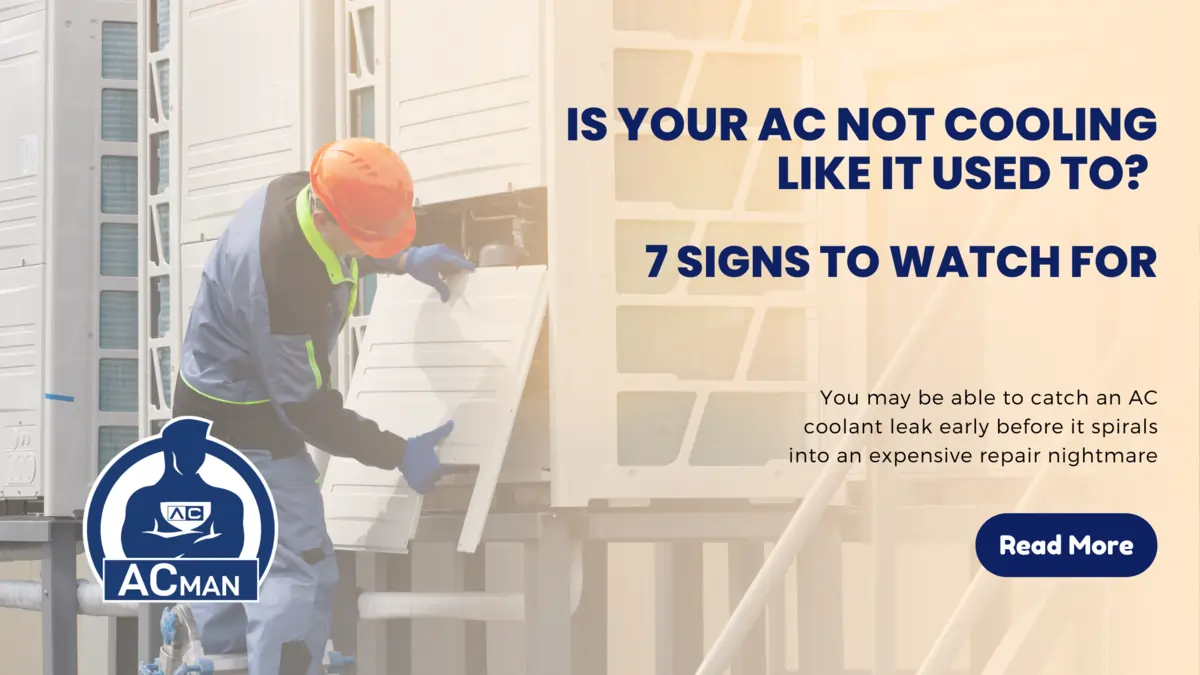There’s nothing worse than cranking up the AC on a sweltering summer day only to realize it’s just blowing warm air. If your air conditioner isn’t cooling properly, one potential culprit could be a refrigerant leak. Refrigerant, also called coolant, is the lifeblood of your AC system. It allows the AC to remove heat and humidity from the air inside and expel it outdoors. When coolant levels get low due to an AC coolant leak, it severely hampers your AC’s cooling ability.
A properly functioning AC unit should maintain a set refrigerant level and not need refills or “top-offs” under normal circumstances. If your AC leaks coolant, adding more refrigerant is just a temporary band-aid that won’t fix the underlying issue. The real solution is first to locate and repair the source of the AC coolant leak.
Refrigerant leaks can occur for various reasons, such as deterioration of copper refrigerant lines, loose connections, inferior installation, system defects, or just plain old wear and tear over time. Whatever the cause, getting an AC coolant leak addressed quickly is crucial. Leaking refrigerant can strain your AC components, leading to premature failure, and refrigerants can also be toxic when leaked into your home’s air supply.
Common AC Warning Signs to Watch

To help you determine if your AC system has a potential refrigerant leak, here are seven common warning signs to watch out for:
- AC Not Cooling or Longer Cooling Cycles – When there’s not enough refrigerant circulating through the system due to an AC leaking, one of the first signs is that your home struggles to get cool and stay cool. The AC may run for long stretches trying to reduce the temperature but can’t reach the set point on the thermostat. Rooms may start feeling warm and clammy.
- Warm Air From Vents – As a corollary to poor cooling, you may notice that the air blowing out of your vents and registers doesn’t feel as cool as it should. Do the basic checks, like ensuring your thermostat is set to “cool” and not “heat,” but if it seems like the AC is running but not pushing out cold air, low refrigerant could be the problem.
- Ice/Frozen Evaporator Coil – Under normal operation, the refrigerant absorbs heat from the inside air, carried by the blower over the AC’s evaporator coils. When levels are low, the evaporator coils can get too cold, causing the condensation around them to freeze with ice. This restricts airflow, and the air handler’s fan motor has to work harder, which could lead to compressor damage.
- Leaks/Moisture Around Air Handler – An iced-over evaporator coil can also lead to water leaks around your AC’s indoor air handler unit as the ice melts off and overflows the condensate drain pan. If you see excessive moisture or leak puddling in this area, it could point to a refrigerant leak.
- Hissing or Bubbling Noise – Because refrigerant circulates under high pressure, a leak may produce an audible hissing or bubbling noise around the inside or outside AC components. A hissing noise usually indicates a smaller leak, while a loud bubbling noise could mean a larger, more severe leak is occurring.
- Rising Energy Bills – When your AC can’t cool efficiently due to low AC coolant levels, it will work harder and run longer cycles trying to compensate. All this increased energy consumption will be reflected in higher electricity bills compared to the previous year’s costs for the same season. A spike in energy usage could be the first sign of an AC leaking refrigerant.
- Find the Telltale Residue – Refrigerants like R-22, can leave an oily residue if there’s a leak in the refrigerant lines. You may see this residue around the indoor or outdoor AC components, like the compressor housing. The presence of this residue would confirm there is likely an AC leaking situation.
What to Do If You Suspect an AC Coolant Leak Because refrigerants can be hazardous if leaked into your home’s breathing air, you should never try to repair a potential leak yourself. Only an EPA-certified and trained HVAC professional should handle refrigerant leaks.
They have the proper equipment to safely evacuate the remaining refrigerant from your system and pressure test it to pinpoint the exact location of the leak. Once the leak source is repaired, they can recharge your system to the manufacturer-specified refrigerant levels.
When the leaks are widespread or the AC components are excessively worn, the technician may recommend replacing rather than repairing the leaking component, like the AC coil or compressor. If your AC system is over 10-15 years old already, you may be better off replacing the entire unit with a new, more efficient model that uses an approved, environmentally safer refrigerant.

Either way, topping off refrigerant levels without repairing an AC coolant leak is a temporary fix that will leave you paying indefinitely for more refrigerant refills. It’s better to bite the bullet and get the proper repair or replacement to restore your system’s cooling capacity and prevent further energy waste.
Keep Your Cool and Catch AC Leaks Early
Keeping a keen eye out for these seven warning signs can help you catch an AC coolant leak early before it leads to an expensive breakdown or replacement. At the first indication of warm airflow, rising energy bills, strange AC noises, or moisture leaks, play it safe and schedule a service call with a reputable HVAC company in your area.
By having them fully inspect, test, and fix any refrigerant leaks you may have, you can get your AC blowing ice cold again and prevent longer-term damage to prolong your system’s lifecycle. An AC coolant leak is no trivial issue, so don’t let it linger until your AC stops cooling altogether in the peak of summer!











